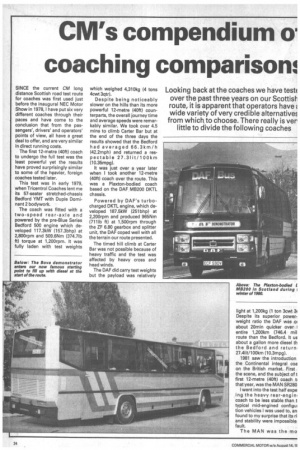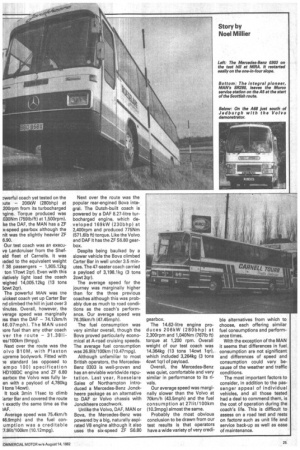• CM's compendium oi coaching comparison:
Page 16

Page 17

If you've noticed an error in this article please click here to report it so we can fix it.
Looking back at the coaches we have test( over the past three years on our Scottish route, it is apparent that operators have wide variety of very credible alternative from which, to choose. There really is ver little to divide the following coaches
SINCE the current CM long distance Scottish road test route for coaches was first used just before the inaugural NEC Motor Show in 1978, I have put six very different coaches through their paces and have come to the conclusion that from the passengers', drivers' and operators' points of view, all have a great deal to offer, and are very similar in direct running costs.
The first 12-metre (40ft) coach to undergo the full test was the least powerful yet the results have proved surprisingly similar to some of the heavier, foreign coaches tested later.
This test was in early 1979, when Tricentrol Coaches lent me its 57-seater stretched-chassis Bedford YMT with Duple Dominant 2 bodywork.
The coach was fitted with a two-speed rear-axle and powered by the pre-Blue Series Bedford 500 engine which developed 117.3kW (157.3bhp) at 2,800rpm and 509.6Nm (374.7Ib ft) torque at 1,200rpm. It was fully laden with test weights which weighed 4,310kg (4 tons 4cwt 3qtr).
Despite being noticeably slower on the hills than its more powerful 12-metre (40ft) counterparts, the overall journey time and average speeds were remarkably similar. We took over 4.5 mins to climb Carter Bar but at the end of the three days the results showed that the Bedford had averaged 66.3 km/h (42.2mph) and returned a respectable 27.3 lit/ 100 km (10.35mpg).
It was just over a year later when I took another 12-metre (40ft) coach over the route. This was a Plaxton-bodied coach based on the DAF MB200 DKTL chassis.
Powered by DAF's turbocharged DKTL engine, which developed 187.5kW (251bhp) at 2,200rpm and produced 965Nnn (711Ib ft) at 1,500rpm through the ZF 6.80 gearbox and splitter unit, the DAF coped well with all the terrain our route presented.
The timed hill climb at Carter Bar was not possible because of heavy traffic and the test was affected by heavy cross and head winds.
The DAF did carry test weights but the payload was relatively light at 1,200kg (1 ton 3cwt 3( Despite its superior powerweight ratio the DAF was oi about 20min quicker over entire 1,200km (746.4 mil route than the Bedford. It us about a gallon more diesel th the Bedford and return' 27.41it/100km (10.3mpg).
1981 saw the introduction the Continental integral coa on the British market. First the scene, and the subject of t first 12-metre (40ft) coach ti that year, was the MAN SR280 I went into the test half expe ing the heavy rear-engin, coach to be less stable than t typical mid-engined configui tion vehicles I was used to, an found to my surprise that its ri and stability were impossible fault.
The MAN was the mo Dwerful coach yet tested on the Kite 206kW (280bhp) at 200rpm from its turbocharged Nine. Torque produced was 030Nm {7591b/ft) at 1,500rpm). ke the DAF, the MAN has a ZF x-speed gearbox although the nit was the slightly heavier ZF 6.90.
Our test coach was an execuve Landcruiser from the Shefeld fleet of Carnells. It was laded to the equivalent weight f 38 passengers — 1,905.12kg ton 17cwt 2qr). Even with this slatively light load the coach reighed 14,005.12kg (13 tons 5cwt 2qr).
The powerful MAN was me uickest coach yet up Carter Bar nd climbed the hill in just over 3 iinutes. Overall, however, the verage speed was marginally ss than the DAF — 74.12km/h 46.07mph). The MAN used lore fuel than any other coach ver the route — 31.3 81ies/100km (9mpg).
Next over the route was the olvo B1 OM, with Plaxton upreme bodywork. Fitted with le standard (as opposed to empo 1 0 0) specification HD100DC engine and ZF 6.80 earbox the Volvo was fully laen with a payload of 4,780kg tons 14cwt).
It took 3min 11sec to climb :arter Bar and covered the route exactly the same time as the 1AF.
Average speed was 75.4km/h Th.9mph) and the fuel conumption was a creditable 7.91it/100km (10.12mpg). Next over the route was the popular rear-engined Bova integral. The Dutch-built coach is powered by a OAF 8.27-litre turbocharged engine, which developed 169kW (230bhp) at 2,400rpm and produced 775Nm (571.6Ib ft) torque. Like the Volvo and DAF it has the ZF S6.80 gearbox, Despite being baulked by a slower vehicle the Bova climbed Carter Bar in well under 3.5 minutes. The 47-seater coach carried a payload of 3,198.1kg (3 tons 2cwt 2qr).
The average speed for the journey was marginally higher than for the three previous coaches although this was probably due as much to road conditions as the coach's performance. Our average speed was 76.35km/h (47.45mph).
The fuel consumption was very similar overall, though the Bova proved particularly economical at A-road cruising speeds. The average fuel consumption was 26.91it/100km (10.47mpg).
Although unfamiliar to most British operators, the MercedesBenz 0303 is well-proven and has an enviable worldwide reputation. Last year, Roeselare Sales of Northampton introduced a Mercedes-Benz Jonckheere package as an alternative to DAF or Volvo chassis with Jonckheere coachwork.
Unlike the Volvo, DAF, MAN or Bova, the Mercedes-Benz was powered by a big, naturally aspirated V8 engine although it also uses the six-speed ZF S6.80 gearbox.
The 14.62-litre engine produces 2 0 6kW (2 8 0 bhp) at 2,300rpm and 1,040Nm (767Ib ft) torque at 1,200 rpm. Overall weight of our test coach was 14.364kg (13 tons 14cwt lqr), which included 3,264kg (3 tons 4cwt 1qr) of payload.
Overall, the Mercedes-Benz was quiet, comfortable and very similar in performance to its rivals.
Our average speed was marginally slower than the Volvo at 70km/h (43.5mph) and the fuel consumption at 271it/100km (10.3mpg) almost the same.
Probably the most obvious conclusion to be drawn from our test results is that operators have a wide variety of very credi
ble alternatives from which to choose, each offering similar fuel consumptions and performance times.
With the exception of the MAN it seems that differences in fuel consumption are not significant and differences of speed and consumption could vary because of the weather and traffic conditions.
The most important factors to consider, in addition to the passenger appeal of individual vehicles, and all those tested had a deal to commend them, is the cost of operation during the coach's life. This is difficult to assess on a road test and rests on factors such as unit life and service back-up as well as ease of maintenance.














































